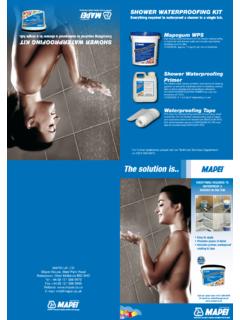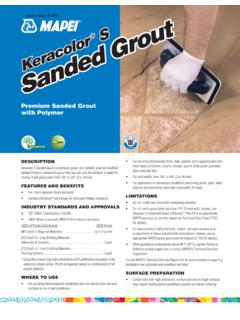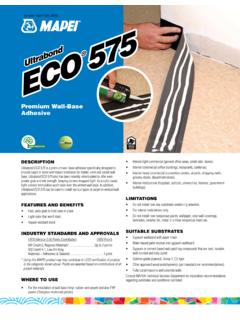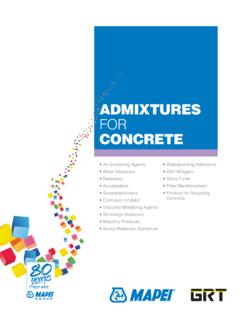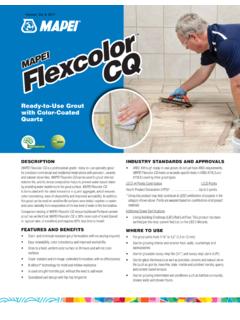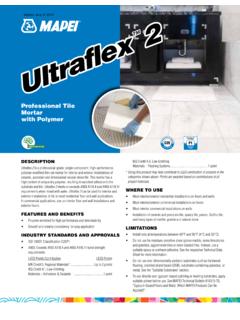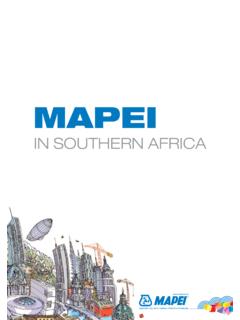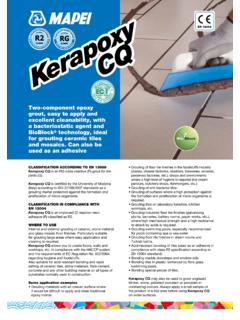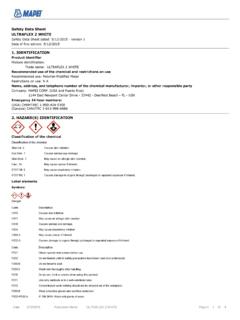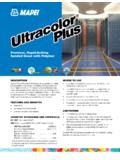Transcription of EN 12004 - Mapei
1 CLASSIFICATION IN COMPLIANCE WITH EN 12004 Kerabond T is a normal (1) slip-resistant (T) cementitious (C) adhesive of class of Kerabond T is declared in ITT certificates n 25050176-1/Gi (TUM) and n 25080238/Gi (TUM) issued by the Technische Universit t M nchen laboratory (Germany) and in ITT certificates n NPU; NPU and NPU issued by the ITB Katowice Institute (Poland).WHERE TO USE Indoor and outdoor fixing of ceramic tiles and mosaics of all types on floors, walls and ceilings. Spot bonding of insulating materials such as expanded polystyrene, expanded polyurethane, rock and glass wool, Heraclit wood-cement and sound-deadening panels, application examplesPaper-faced or mesh-backed mosaics and all types of ceramic tiles (quarry tiles, single fired and klinker tiles, etc.)
2 , on: conventional renders or cement mortar walls; ordinary concrete slabs or reinforced floating slabs, provided they are sufficiently well aged and dry; gypsum supports and anhydrite screeds as long as they are first treated with a CHARACTERISTICSK erabond T is a grey or white powder composed of cement, fine-grade, synthetic resins and special admixtures formulated in the Mapei Research and Development with water, Kerabond T becomes an easily trowellable mortar with good bonding strength, low slump and high grab so that it can be applied vertically without sagging.
3 Even holding heavy is possible to install from the top towards the bottom without using spacer T hardens without noticeable shrinkage to become extremely resistant, adhering perfectly to all the conventional materials used in : Mixing Kerabond T with Isolastic in place of water improves the characteristics to meet the requirements of class C2ES2 (highly deformable improved cementitious adhesive with extended open time) according to EN Kerabond T mixed with Isolastic in the following cases: on foamed concrete walls; on pre-cast or cast-concrete structures; over underfloor heating installations; with large-size tiles; for the installation of glass mosaics; for the installation of stone materials as long as they are stable and moisture not use Kerabond T in the following cases: on wooden substrates; on gypsum board walls; on metal, rubber, PVC and linoleum surfaces.
4 Kerabond TKerabond TEN 12004 EMICODEGEVC ementitious adhesive with no vertical slip for ceramic tiles IN COMPLIANCE WITH EUROPEAN STANDARDS CEMENTITIOUS ADHESIVE FOR CERAMIC TILES EN 12004 for floors, very irregular surfaces and tiles with high ribs or lugs, the Mapei No. 6 V-notched trowel (consumption approx. 5 kg/m ) is recommended; in the case of outdoor ceramic floor and wall coverings subject to freezing, or in the case of other special uses such as swimming pools reservoirs, sizes larger than 9 dm , floors to be polished after installation or subject to heavy loads, Kerabond T should be applied evenly to the back of the tile (back-buttering).
5 Installing the tilesIt is not necessary to wet the tiles before installation; if, however, the backs are very dusty, they should be wiped in clean the tiles with a firm pressure to ensure good contact with the T s open time in normal temperature and humidity is 20-30 minutes; unfavourable weather conditions (strong sun, drying wind, high temperature), or a highly absorbent substrate may shorten this open time, sometimes quite drastically, to just a few must be constant checks to see whether the adhesive has formed a surface skin or is still fresh to the a surface skin have formed, the adhesive should be retrowelled.
6 It is inadvisable to wet the adhesive when it has formed a skin because, instead of dissolving the skin, a non-adhesive film will be of the tiles, if necessary, should be carried out within 45 minutes following installation, after which time, adjustment will become installed with Kerabond T must not be subject to washout or rain for at least 24 hours and must be protected from freezing and direct sun for at least 5-7 days after bonding insulating materialsSpot bonding of sound-deadening or insulating panels should be applied using a float or trowel.
7 The required number and thickness determined by the flatness of the surface and weight of the these cases too, the open time must be observed, bearing in mind that a few spots of adhesive on heavy panels may require temporary shoring which should then only be removed after the Kerabond T has begun to AND SEALINGWall joints between ceramic tiles can be grouted after 4-8 hours and floor joints can be grouted after 24 hours with the specific Mapei cementitious or epoxy grouts, available in different joints must be sealed with the specific Mapei TO LIGHT FOOT TRAFFICF loors are set to light foot traffic after approximately 24 hours.
8 For laying tiles which require a layer of adhesive more than 5 mm thick; where the surface must be set to light foot traffic rapidly; for the installation of non-absorbent tiles (quarry tiles, single-fired tiles, klinker tiles, etc.) on other non-absorbent wall and floor PROCEDUREP reparing the substrateThe substrates must be cured, mechanically strong, free from loose particles, grease, oils, paint, wax and sufficiently substrates must not be subject to shrinkage after the installation of the tiles. During spring and summer, renders must be cured for at least one week for every centimetre of thickness and cement screeds must be cured for at least 28 days, unless they have been made with Mapei special binders for screeds such as Mapecem, Mapecem Pronto, Topcem or with Topcem with water to cool surfaces which have been heated by exposure to substrates and anhydrite screeds must be perfectly dry, sufficiently hard and free from dust.
9 It is absolutely essential that the surface is abraded and then treated with Primer G or Eco Prim T. Areas subject to high humidity should be primed with Primer general, refer to the relative Mapei technical documentation regarding substrate preparation before repairing cracks in substrates, consolidating rapid-drying screeds and levelling off installation the mixKerabond T must be mixed with clean water to obtain an homogenous lump free paste; after 5-10 minutes resting, it must be re-mixed. The paste is then ready for quantity of water to be used is approx.
10 26 parts per 100 parts (by weight) of Kerabond T (equal to approx. litres of water for 25 kg of powder).Always refer to the quantity of mixing water prescribed on the mix, produced in this way, is workable for at least 8 the mixKerabond T is applied with a notched trowel onto the substrate. Choose a trowel that will give a coverage to the back of the tiles of at least 65-70% for walls or for indoor light foot traffic. For heavy traffic, total immersion and for outdoor application, the coverage must be 100%.To obtain good adhesion to the substrate the following system is recommended: first apply a thin coat of Kerabond T using the smooth side of the trowel and immediately after apply the desired thickness of Kerabond T using the toothed side of the trowel.
